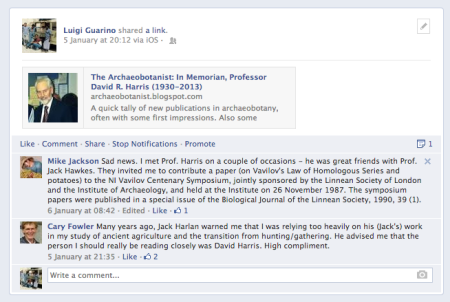- The need for seed.
- If you need to know about the conservation of animal genetic resources in India, this hour-long video may be just what you’re looking for.
- Reconstructing Mesoamerican chocolate.
- Re-imagining West African cooking.
- ICRISAT finds 6 cool chickpea varieties in its genebank. No word on who lost them in the first place.
Nibbles: Bovine flatulence, New bananas, Cyperus, Pepper history, Ancient rice, Indian Act, Indians act, CIFOR achievements, Pooch podcast, Milk, Buzz, Commons, Sorghum sociology, Water spinach meme, AGRF
- The taxonomy of cow farts. Can’t improve on that title.
- What the hell is Hawaiian Plantain, and why is it needed in Panama?
- Ever eat a sedge?
- Bet they could do with some pepper.
- Ancient Japanese rice found. Let the DNA extraction begin.
- Indian farmers can now claim royalties on traditional varieties. What could possibly go wrong?
- How about paying them to preserve “traditional and fast disappearing millets“?
- Video on CIFOR’s greatest successes. I think the greatest failures would be more instructive.
- Self-consciously cool (but don’t let put you off) podcast on the domestication of the dog.
- The evolution of human lactose persistence, however, is not all about calcium.
- Today’s theory about honeybee deaths is sure to be discussed at today’s honeybee health summit.
- Can participatory mapping save the commons? Probably not, but fun nevertheless.
- Fun? How about the successful defence of a thesis on “The social structure of cultivated plants: the influence of exchanges, representations and practices on sorghum diversity in Mount Kenya’s people”.
- Keep calm and eat kangkung. Don’t you love it when one meme eats another?
- Say you want an African Green Revolution Forum … Well, you know, go to Maputo.
Nibbles: British foods, NBPGR wheat, CIMMYT wheat, Innovation, Ghana cowpea, Nordic grog, Medicinal purposes, Heirloom chocolate, Grünewoche, Dog genomics, Berry go Round, Broad beans, Ag landscapes, Tea and CC
- Google Map of British protected food names. Where’s fish and chips? Or the cream tea. Japan next?
- Indian genebank in the record books for characterizing wheat.
- And with no help from CIMMYT!
- Getting those damn smallholders to innovate already.
- Ghana gets a new cowpea to innovate with. Well, almost.
- And there I was thinking smallholders had been innovating for thousands of years. Even in the frozen north. Winter may be coming, but we’ve got grog. Which you know is good for you.
- As is chocolate, so go ahead and submit your heirloom cacao beans for evaluation. But don’t be tempted to cheat. We’ll know if you are.
- Oh damn, it’s Green Week.
- The story behind the methods used in a recent paper on dog diversity. Wonkish.
- We seem to have slipped off the Berry Go Round treadmill, which means we missed some gorgeous photos of broad beans.
- And another belated treat: UNESCO’s round up of World Heritage agricultural landscapes.
- …one of which is not tea in China, but maybe it should be, before it’s too late.
Prof. David Harris RIP
Prof. David Harris, one of the giants of the study of the origins of agriculture, died during the holiday period. He was Professor Emeritus of Human Environment at the Institute of Archaeology (UCL) and a former director of the institute (1989-1996). Dorian Fuller, a friend and colleague at the institute, has an informative and touching piece about Prof. Harris on his blog. The comments there, and on my re-posting of Dr Fuller’s piece (see below), are ample evidence of Prof. Harris’ impact and legacy.
Nibbles: Potato journeys, European collections, European bees, Wheat breeding, Mountains, Forest restoration, Tall trees, Symbioses, Guanaco reintroduction, Plant genomes, Improving GBIF, 2 sides of beef
- The European encounter with the potato. A Google Earth tour by Jorge L. Alonso, and really rather fun. In Spanish.
- The European encounter with virtual germplasm collections. AEGIS takes another step.
- The European encounter with the honeybee. Bad news for the latter.
- The European encounter with wheat. Its promiscuity will save us. Wheat’s, that is, not Europe’s. No, wait…
- Nope, mountains will save us. Including Europe’s?
- We should be doing reforestation in discrete patches, not huge swathes. Even on mountains, I suppose.
- But if you want those trees to grow really tall, your options are limited.
- No harm in adding a few fungi though. On the contrary…
- And maybe a few guanacos?
- Well we must have at least one genome piece in Nibbles, mustn’t we? Turns out plants are good models for everything else, including us.
- And one database hell piece too, natch. Some thoughts on improving GBIF. Could be applied to Genesys too, I fear.
- Meat: One side, and the other.
